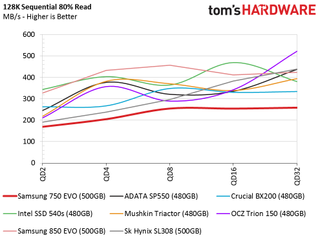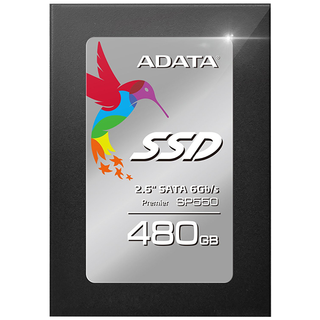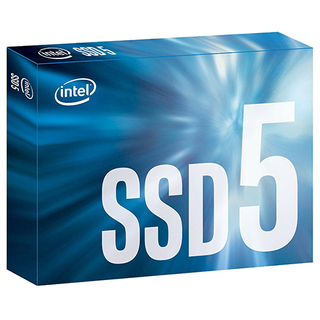Samsung 750 EVO 500GB SSD Review
Samsung opened up the 750 EVO to the mass market and added a 500GB model, which will allow the company to fight in the low end with a game-changing mix of mainstream performance and entry-level endurance.
Why you can trust Tom's Hardware
Benchmarks And Comparisons
Comparison Products
The Samsung SSD 750 EVO 500GB packs mainstream performance but entry-level endurance specifications, which is a game-changing mix that can disrupt the entry-level SSD market.
We chose a combination of entry-level and mainstream SSDs to compare to the 750 EVO. The Adata SP550, Crucial BX200, Mushkin Triactor, and OCZ Trion 150 make up the entry-level products with prices that range from $109.99 to $120.99.
The mainstream products include the Intel SSD 540s and the SK hynix SL308, which both feature planar SK hynix 16nm TLC NAND, and the industry-leading Samsung 850 EVO with 3D TLC NAND. The new SL308 starts the mainstream pricing at $129.99, while the Intel 540s retails for $143.99 and the Samsung 850 EVO is at $159.99. The 750 EVO 500GB now sells for $149.99 at several large resellers.
Every product in the chart utilizes 3-bit per cell flash, which marks the first time we've removed all MLC products from an entry-level chart. MLC prices have shot up, taking retail SSD pricing with it. TLC flash is projected to achieve 80% market share by the end of 2016, which is an eventually that we've warned about for several months. Like it or not, now if you want MLC you have to pay a premium for it.
To read about our storage tests in-depth, please check out How We Test HDDs And SSDs. Four-corner testing is covered on page six of our How We Test guide.
Sequential Read Performance


All of the products in our test deliver strong sequential read performance. The Crucial BX200 480GB is the only drive that fails to exceed 500 MB/s at low queue depths. The Samsung 850 EVO leads the 750 EVO by 21 MB/s at QD2.
Sequential Write Performance
Many of the products on the chart have inconsistent write performance. All of the SSDs in the test use some form of SLC-programmed buffer area to increase burst performance while writing data, which creates two tiers of sequential write performance. Some of the SSDs write 128 KB sequential data at less than 100 MB/s after they have exhausted the SLC buffer.
The Samsung SSD 750 EVO delivers nearly 500 MB/s in the SLC buffer zone and 325 MB/s of native TLC performance. The performance is much higher than the other products (barring the 850 EVO and SK hynix SL308).
SLC buffers are becoming the norm, so we are working on a new test that will measure SLC and TLC performance separately, which will allow us to list the results in different charts. Companies tackle the SLC buffer differently, so we are working to isolate the variable amount of SLC area. Some manufacturers use a static volume with a fixed buffer size, while others use a dynamic volume that alters the buffer size based on how much data the user has stored on the flash.
Random Read Performance



The SSD 750 EVO follows the 850 EVO, and even the 850 Pro, with high random performance at queue depth 1. The new SK hynix SL308 nearly hits the same milestone, but the other TLC-based products can't compete. Samsung SSDs are excellent at real-world application performance, and this synthetic test shows why. This test defines the gap between Samsung and the other entry-level SSDs, just as it has highlighted the difference in the mainstream and premium markets for the last two years. Samsung has engineered in some SSD magic at low queue depths and is using it to dominate the market.
The 750 EVO even outperforms the 850 EVO in random reads at high queue depths. The 750 EVO's controller has a year of firmware maturity under its belt, and Samsung used the time to optimize performance.
Random Write Performance



Random performance defines the user experience during a normal desktop workload, and Samsung runs away from the competition again. The 750 and 850 EVO deliver superior small block performance at low queue depths, but the Samsung SSDs also scale very well up to higher queue depths.
80 Percent Sequential Mixed Workload
Our mixed workload testing is described in detail here, and our steady state tests are described here.

The SSD 750 EVO 500GB trailed by a small amount in both of our previous sequential tests, but the small delta wasn't enough to lop off this much performance during a mixed read/write workload. It appears the 2-core version of the MGX controller can't deliver the same performance in a mixed sequential workload as the Samsung 3-core controllers.
When Samsung introduced its 3-core design it announced that it dedicated one core to reading, one to writing and the other to background activity. We translated that into one for reading, one for writing and one for arithmetic. The mixed sequential workload chart reveals that the 750 EVO's performance slows when you move three CPU-intensive tasks to just two cores.
80 Percent Random Mixed Workload

The SSD 750 EVO's dual core architecture wasn't enough to drag its performance down to the level of other TLC SSDs during a mixed random workload. The other products deliver low random performance to start with, but the two Samsung SSDs deliver very high random performance during the entire test.
Sequential Steady State



Samsung did not target the 750 EVO at the professional market, and the steady state performance reveals that users should avoid using it for extreme write environments. The endurance ratings indicate the same, but that won't stop some users from trying.
Random Write Steady State


The SSD 750 EVO is a beast with random data. The performance stays over 5,000 IOPS and remains consistent even under steady-state conditions. We didn't expect performance to remain this high, and you can see that many of the other entry-level TLC-based products have a difficult time in this test; some SSDs can even drop to the single-digit IOPS range during intense workloads.
Current page: Benchmarks And Comparisons
Prev Page Specifications And Features Next Page Performance And ConclusionStay On the Cutting Edge: Get the Tom's Hardware Newsletter
Join the experts who read Tom's Hardware for the inside track on enthusiast PC tech news — and have for over 25 years. We'll send breaking news and in-depth reviews of CPUs, GPUs, AI, maker hardware and more straight to your inbox.
-
Dark Lord of Tech Bought the 120GB one for a boot drive a couple of months ago , very good performance , well done Samsung.Reply -
hardrock152 Honest (and possibly stupid) question:Reply
The 500 gB version of this costs essentially the same as the 500 gB 850 EVO on amazon. Isn't the 850 Evo a better product, or am I missing something internally (does the TLC flash have some benefit over the 850 EVO)?
Sorry if this is dumb, just kind of curious. -
lucas_7_94 Reply18331527 said:Honest (and possibly stupid) question:
The 500 gB version of this costs essentially the same as the 500 gB 850 EVO on amazon. Isn't the 850 Evo a better product, or am I missing something internally (does the TLC flash have some benefit over the 850 EVO)?
Sorry if this is dumb, just kind of curious.
In a fast view, the only -big- difference i can see is the warranty. 5 years from 850 vs 3 years from 750.
-
jossrik I don't see 170$ for an entry lvl SSD being competetive, if money is an issue, you're going to go with the 100$ 500Gb class SSD over a spinning drive. It's not like there's a fire sale on the 500Gb drives, there are several that are in the 100$ range on the Egg right now, and I just bought a 1TB off the egg with a promo code that cost me 185. Is it a Sammy? No, but will the end user know the difference between it and the Samsung 500Gb? Nope. They will notice the extra 500Gb though. SSDs are reliable enough that under normal use we expect them to last the duration of their warranties and then some, to the point where we don't really worry about Tbs written.Reply -
chalabam It is clearly bottlenecked by SATA.Reply
And since I have no reason to upgrade my mother, the only way that SATA SSD can offer better performance to me is to add multiple SATA cables, and a special driver, to emulate RAID0 with a single drive, or something. -
DynamoNED Priced a little lower, I think the 750 EVO could solidify Samsung's dominance (not necessarily a good thing, BTW). At this price, it's just not worth it over the 850 EVO.Reply -
AndrewJacksonZA Reply
I just paid +-USD112 for a 500GB Samsung 750 EVO yesterday. It's going to replace my 120GB Seagate SSD. Where did you get the price of USD170 from jossrik?18333765 said:I don't see 170$ for an entry lvl SSD being competetive
Yeah, I'm aiming for at least 5 years worth of use out of this drive, hopefully much more. To that end I think I'll only use the first 400GB, maybe 420GB of this drive, I'll try and keep the rest unused. However, this is just me. Does anyone know if now using all of the drive actually increases it's lifespan? I would imagine so since the wear-levelling algorithms have "more" spare space (the unallocated space.) However, wear-levelling algorithms aren't my area of speciality, so I'm just making educated guesses.18333765 said:SSDs are reliable enough that under normal use we expect them to last the duration of their warranties and then some, to the point where we don't really worry about Tbs written.
Can anyone clear this up for me please? -
Onus I just pulled a 250GB Samsung 830 from a system that had become quite balky and was experiencing some data corruption. While not heavily-used the last few years, the drive is probably at least six years old; I'll say I got my money's worth.Reply -
AndrewJacksonZA Thank you Onus, but it can't be that old, Onus! SSDs were first released only a few years ago!Reply
...
Hmmm... a review on 2011/09/24?! 2011?!?!
My, my... It's said that a day might be long but a year is a very short space of time. Do we really appreciate the weight of that statement?



